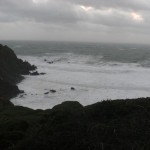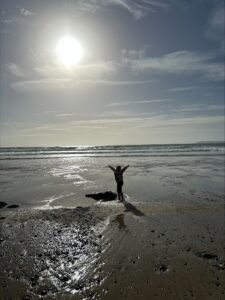An Early Winter Storm
Its nice to visit Pembrokeshire at different seasons to see the changes. One time when we had three young children we decided to have a holiday in Pembrokeshire in October at the school half term. On this occasion we rented a large caravan in a caravan park situated on the top of a hill on the coastline overlooking the Irish Sea. The caravan park proved to be mainly deserted and we enjoyed the windy Autumn weather and selected beaches that were sheltered by high cliffs from whatever directions the wind blew.
One morning, towards the end of our stay, we noticed a great bank of grey-black clouds slowly approaching and the blue sky and sunshine disappeared. It was obviously the first storm of winter approaching. The sky became blacker and increasingly turbulent and increasingly powerful gusts of wind began to hit the caravan. We remained inside our large caravan which like most in the park had a vast end bay window with a comfortable bench along the inside. The children were sitting on the bench and we were all watching the sky and listening to the buffeting that the caravan was getting from the gusts of wind. I had noticed that the caravans in the park had strong chains wrapped around their axels and disappearing into the ground where they were anchored to concrete blocks. I assumed that as the hilltop was rather exposed, the caravans were anchored to the ground to stop them blowing over or moving and I said something reassuring about this to my family.
We were all sitting there, adults with cups of morning coffee and buns and the children with coloured fizzy things, admiring the sky and listening to the wind gusts hitting the caravans when we suddenly heard the sound of smashing glass. A few minutes later it happened again and I suddenly realised that the big bay windows on the caravans were beginning to be blown into the caravans by the strong winds. The family were surprised when I called out “Come on everybody, away from the windows. We must pack up quickly and leave. The windows are blowing in.” Everybody packed and the car boot was soon filled. With everybody inside the car we got out of the caravan park. It was still early in the morning and we had decided to drive back to the family home in Kent that day. However before leaving I thought it might be of interest for the family to do some storm watching. So we drove to Dale and then took the road up the hill behind Dale castle. We parked by the side of the road in the small car park where the track leads down to West Dale beach. The car was buffeted by loud gusts of wind and the horizontal rain beat a tattoo that rose and fell with the gusts against the side of the car. It needed the windscreen wipers to be able to see outside where we could look into West Dale Bay. We watched in awe as great swells of yellow sand charged sea rolled majestically to their destruction against the red sandstone cliffs bounding the bay. They burst in walls of spray that drenched the entire cliff up to the grass line at the top (this explained why the cliff faces are usually grass free). There was no beach exposed but a white maelstrom of foaming sea surging back and fore against the cliffs. The rocks pinnacles along the south side of West Dale Bay were immersed in white surf that was being carried back out to sea in a rip current along the south side of the bay. From this area and from the beach itself, lumps of foam or spindrift were being whipped up the cliff face and blown into the adjacent fields (which explains the asymmetry of the trees and bushes of the cliff top which are salt burned).
Next we drove on a short distance to the end of the road by the gate into Marloes World War II airfield and parked there (nobody else was about this day) to look over the 120 foot high cliff line. It is only a short distance to the edge of the high cliffs on the coast path. The wind was gusting so hard and the rain was blowing horizontally that only myself and our eight year old son elected to get out of the car. It was cold and I held Peters hand as he was being pushed around by the wind that delighted him and he shrieked and squeaked. We ran to the cliff path and lay on it and stuck our heads over the edge to look down. The gusts were so strong that I had to put an arm over him to stop him being blown away and we conversed in shouts (with our heads about an inch apart) about what we could see when our eyes were not to filled with water. It was a most spectacular scene and we were looking at something rarely seen of Nature running wild. Line upon line a great black-green waves with rolling heads of surf were advancing to their destruction against the jagged rocky cliffs. As each wave crashed against the cliffs there was a great roar of angry water. Along the cliff line was a wide belt of white surf in which black rocks appeared and disappeared. On top of the cliffs the gorse bushes and grasses were being combed by the wind and were shivering. What most impressed us was that along the top of the cliffs several streams of water were pouring over the edge of the cliffs and were being picked up by the roaring wind and redirected up into the air in large circles about 80 feet in diameter, to be sprayed back into the fields. Overhead many grey-black storm clouds were racing past at a low level. When we got back to the car I asked Peter to draw me a picture what he had seen. He did this (aged 8 years) and it is attached below. The steeply dipping bedding of the red cliffs is shown as wavy lines with the two of us lying on the cliff path with the gorse and grass. The surf belt at the foot of the cliffs is shown and a breaker approaching. The loop in the sky is one of the rain water streams being redirected by the wind back into the fields.
We then set off for the M4 and the drive back to Canterbury. On arrival in Canterbury (some 320 miles further east) we found a calm warm sunny day with hardly a breath of air. It seemed improbable that we had been in a such a great storm only that morning. A few days later we learned from my sister who lives in St. Ishmaels on the Dale peninsula, that the storm had increased in strength after we left. What prompted her to telephone was the news that our rented caravan, an old one, had completely disintegrated in the wind and the pieces had blown away to leave only the chained down axels and wheels. Soon afterwards I bought us small old house in Pembrokeshire with stone walls three feet thick.






